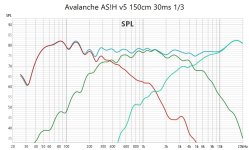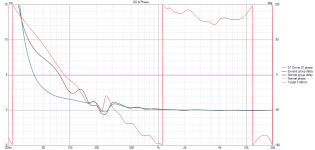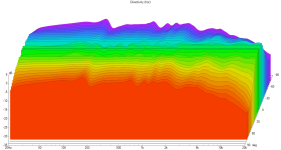As the title says…..the core of the music spectrum where nearly all of the fundamentals live…..how would you handle it?
Smoothly, and maybe with just a single midrange driver.
Tang Band W5 2143 might do the job:
From DiBirama, crossover from 300-3,000

From DiBirama, crossover from 300-3,000
Core fundamentals of most instruments start quiet a bit lower, most start below 200Hz. A lot of common instruments start even an octave lower.
Some would be put off crossing here for this reason. I see that as a complication in an already difficult task. I would focus on designing the speaker correctly.
Probably use one of the coaxial compression drivers on a big-ish horn. I have a pair of BMS 4952 here, and the midrange section of that can cover this range comfortably, with very low distortion.
I built a prototype 18" 3-way with a Faital 18XL1800 and one of those BMS drivers per side. That was a fun pair of speakers.
Chris
I built a prototype 18" 3-way with a Faital 18XL1800 and one of those BMS drivers per side. That was a fun pair of speakers.
Chris
Midrange compression driver with 3 inch exit e.g. JBL 2490H on a large horn like 2392. 😎👍
https://www.audioheritage.org/vbull...e-big-guy-Any-know-anything-about-this-driver
https://www.audioheritage.org/vbull...e-big-guy-Any-know-anything-about-this-driver
For home hifi - basically quite easy task for 4-5" pure midranges. LR2 xo. Woofer(s) acoustic response must be set to handle BSC and have adequate sensitivity. Any reasonable tweeter has easy task.
For disco spl,use bigger mid and a waveguide/horn tweeter https://www.diyaudio.com/community/threads/avalanche-as1-modernization.321711/page-2#post-6553339



For disco spl,use bigger mid and a waveguide/horn tweeter https://www.diyaudio.com/community/threads/avalanche-as1-modernization.321711/page-2#post-6553339



.how would you handle it?
Imo, any speaker design always starts with "for what SPL?", and for "what radiation pattern?"
So, what's your application?
6NDL38 would be one choice for a direct radiator. 6MBX44 possibly if you are using active crossovers.
A Celestion Axi2050 on a K-402 horn (raw & then EQed flat):

Full transfer function of EQed single-diaphragm Axi2050/K-402 assembly:

Spectrogram of the Axi2050/K-402 assembly:

An MEH using a BMS 4592ND on a K-402 Horn, crossed at ~550 Hz and 6.3 kHz, and two Crites 1526C woofers (EQed):

Many apparently do not recognize the acoustic advantages of modern compression drivers like the Celestion Axi2050 (complex axisymmetric ring radiator Ti diaphragm) or the BMS 4592 ND (dual ring radiator polyester diaphragms) on a single straight-sided horn with tractrix or dual flare mouth rollout-like a Danley-style multiple entry horn. These exhibit full-range directivity control down to the room's Schroeder frequency (i.e., no early reflections). The size of the total assembly is about that of a Klipsch La Scala--but sounding and measuring much better in room boundary loading., They do not need to take up valuable floor space away from room walls in order to achieve full soundstage imaging performance. Tuck them in--out of the way--in typically unused room corners or against a wall and they perform even better.
Chris
Full transfer function of EQed single-diaphragm Axi2050/K-402 assembly:
Spectrogram of the Axi2050/K-402 assembly:
An MEH using a BMS 4592ND on a K-402 Horn, crossed at ~550 Hz and 6.3 kHz, and two Crites 1526C woofers (EQed):
Many apparently do not recognize the acoustic advantages of modern compression drivers like the Celestion Axi2050 (complex axisymmetric ring radiator Ti diaphragm) or the BMS 4592 ND (dual ring radiator polyester diaphragms) on a single straight-sided horn with tractrix or dual flare mouth rollout-like a Danley-style multiple entry horn. These exhibit full-range directivity control down to the room's Schroeder frequency (i.e., no early reflections). The size of the total assembly is about that of a Klipsch La Scala--but sounding and measuring much better in room boundary loading., They do not need to take up valuable floor space away from room walls in order to achieve full soundstage imaging performance. Tuck them in--out of the way--in typically unused room corners or against a wall and they perform even better.
Chris
- Home
- Loudspeakers
- Multi-Way
- 3 octaves, 400hz-3200Hz … whatcha gonna do?
